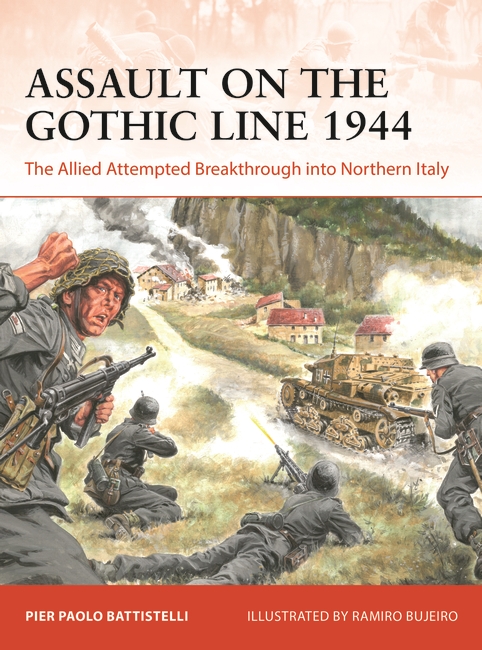
One of the reasons why Osprey’s Campaign Series is to be appreciated is that it brings to surface otherwise forgotten battles and campaigns, like the one fought in Italy in the autumn – winter of 1944. Thanks to the Campaign Series, readers can have access to histories at affordable prices, packed with detailed maps and illustration which will help understanding the situation and put the battle and the campaign within context. Which is what the Gothic Line Campaign title, and its ideal companion in the Air Campaign Series, will provide.
It is undeniable that for most the Italian campaign means the battles of Cassino and Anzio. In some cases readers may get to know of the battles for Sicily and Salerno in 1943, but in general very little is known about the war fought in Italy after the Allied armies entered Rome on 4 June 1944. There is a clear reason for this: the Allied landing in Normandy and the subsequent campaign fought first in Normandy then in North-West Europe put the entire Mediterranean theatre of war into some sort of background, which seemed of little importance or even of little interest. All too often this is not the case, and thanks to the Osprey Campaign Series we can now appreciate the importance of the battles fought in northern Italy in 1944-45.
Two issues dominated the strategic situation in the Mediterranean theatre of war in the summer of 1944: the decision to land in southern France (Operation ‘Dragoon’) and the planned attempt to break through the German defences in Italy to reach the ‘Ljubljana Gap’, the valley in Slovenia representing the gateway to the Balkans and to Austria. The much debated and criticised decision to land in southern France probably represents the most important factor in the Gothic Line campaign. By taking several divisions away from the Italian theatre of war, the Allied offensive capabilities were greatly diminished much to the advantage of the defending Germans. A landing in Italy, either in the west (Tyrrhenian coast) or in the east (Adriatic coast) might have led to the collapse of the German defences in Italy and to a general withdrawal to the Alps, but this is an issue more related to the ‘what if’ history than to the actual campaign.
Command and leadership proved essential in the latest phases of the Italian campaign, as I have had occasion to discover. Field Marshal Alexander’s plan to reach the Ljubljana Gap had to take into account the fact that there were in Italy two Allied armies: a British and an American one. In a way, this prevented a concentration of the effort since both had to be given a role to play in the campaign, with the British 8th Army being tasked at first with breaking through the plain on the Adriatic coast and the American 5th Army being given the task to deliver a second blow on the Apennines mountains. This was also the consequence of the promotion of the American General Mark Clark to commander of the 15th Army Group in Italy in December 1944, a position which had been held until then by British commanders.
From the German point of view, the Gothic Line campaign was some kind of a ‘last stand’. As a matter of fact, the general idea of the entire campaign stemmed from Field Marshal Erwin Rommel’s 1943 plan. This aimed at a general withdrawal to the northern Apennines, followed by a counter-attack in the plains along the Adriatic coast. Since the autumn of 1943 Rommel started the construction of the ‘Gothic Line’ (which would be subsequently renamed ‘Green Line’), even though its development was then neglected to the favour of the ‘Gustav Line’ running along Cassino. In the summer of 1944 Field Marshal Kesselring resuscitated Rommel’s plan, if not for the intended counter-offensive which could no longer be carried out. Construction of the ‘Gothic Line’ was re-started, albeit belatedly and with some crucial mistakes which enabled the 8th and the 5th Army to break through its defences rather easily. This led to a major crisis within the German commands, and preparations for a general withdrawal to the Alps were started: Operation ‘Herbstnebel’, autumn fog.
Which leads us to a crucial question: why the Allies were not able to break through into the Po River valley in 1944, and achieve their goals? In my opinion, there was a crucial mistake. This was the decision to strike the German defences in two different points, rather than try and concentrate the effort with a single, decisive strike. With both the British 8th and the American 5th Army suffering from the lack of infantry troops, on the long run the Germans were able to wear down the attacking enemy forces until the inset of winter and the realisation that the war would not be over by Christmas 1944 led to the conclusion of the Gothic Line campaign.
There are many reasons to make the Gothic Line campaign of interest, if not of importance in the wide context of the Second World War. I trust the readers will be able to judge if the work I have done does answer to some crucial questions, and in case raises other ones.

Comments
You must be logged in to comment on this post. Click here to log in.
Submit your comment